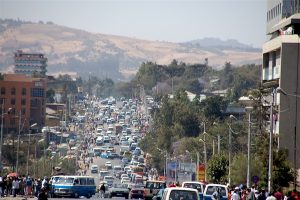AThe times are changing in the Horn of Africa and the larger East Africa region. Ethiopia – once the byword for famine in the region – is now garnering attention from foreign investors. Sitting in the Sheraton Hotel in Addis Adaba, it is hard not to notice the number of private investors from London to Nairobi to Johannesburg passing through and talking about the changing environment and potential of investment in Ethiopia.
Government officials claim an average GDP growth of 10 to 11 percent over the past 7 years. Supporters and critics alike question these figures. International experts, including the International Monetary Fund (IMF), suggest that actual growth numbers average 5 to 7 percent. Regardless of which figures are right – both are respectable – the buzz in the street is justified.

All the excitement can overwhelm and confuse the first time visitor. “You hear all the talk and see all the news,” says one private equity investor from the U.S., “but when walking around you do not exactly see where the opportunity [for investment in Ethiopia] is because you still see so much poverty.”
This article is the first of two parts and is for that investor and every other investor wondering about the best opportunities for investment in Ethiopia. Here are my recommendations from number 5 to number 1 in order of potential return. The top two will be covered in next week’s article.
#1 Financial Services
The African financial services sector has greatly benefited from international banks playing a role in private equity and expansion deals. But such activity has been absent in Ethiopia – home to Africa’s 9th largest economy and 2nd biggest population.
Private investors lurk around banks in Ethiopia, eager to jump into a sector not yet available to them. For now, all they can do is dream about the potential of “almost 90 million people, one of Africa’s biggest economies, and high GDP growth means opportunity for financial services,” says one insider at Standard Bank, “plus don’t forget the huge unbanked population.”
In Africa, the most banked populations are in Mauritius and South Africa at around 82 and 58 percent respectively as of 2012. Experts estimate that Ethiopia’s unbanked population could be as high as 85 to 90 percent. As the Ethiopian economy transitions to the international stage, financial infrastructure will have to facilitate access to the various under-served communities. The recent introduction of mobile banking and related services is surely a step in the right direction.
#2 Telecom Services
Telecommunications is another restricted sector in Ethiopia. Experts estimate that mobile phone penetration in Ethiopia hovers between 10 and 15 percent. Internet penetration is below 1 percent largely due to poor infrastructure and very high prices.
The Ethiopian population will surely surpass 90 million by end of 2013. What mobile phones and internet could do for a population of that size is evident in the stories coming out of Kenya and Nigeria.
“That’s gold,” says one telecom expert. “The upper limit of customers is unknown with a rapidly growing population and increasing incomes.”
The potential of the telecom market is further evidenced by the Ethiopian government recently introducing mobile services for utility payments.
“Right now, the Ethiopian government is trying to make back the money it paid for access to the fiber optic cable,” says a former Seacom employee, but this should change over time.”
Telecom services would surely be number (1) on our list of investment opportunities if the sector were open to foreign investment. As one insider says, “[Telecommunications] is just starting to move in the country. Just wait and see.”

#3 Heavy Construction
Ethiopia’s infrastructure spending, as a percentage of GDP, is the highest in Africa. The Ethiopian government rightfully makes the delivery of infrastructural services, such as transport and energy, a focus of its development plan. Absent the government’s current and continued focus on infrastructure, the development story of Ethiopia would hit a wall.
Heavy construction sectors, including cement and steel, are the ancillary beneficiaries of this infrastructure build. The national building lottery is undergoing expansion in Piassa. As you drive out of Addis, you pass newly built affordable government housing or private housing developments; both promptly filling up after the final touches are added. Pass through Bole and expect to encounter changing roadways, as one road finishes construction and another undergoes it. “I don’t know which road is open today,” says my taxi driver.
It is not just the government. All the buildings under construction in Addis are also a clear indication that those with money are investing in property.
Says Tsege, a local resident, “Walking around Addis is like walking through a major construction site.”
The prices of cement and steel remain high in Ethiopia and in Kenya and Tanzania, both of whom are potential export partners. Transportation and logistics still frustrate some companies, but such frustrations are eased by the government’s focus on transport, especially the rail corridor between Addis Ababa and the Port of Djibouti. Importing certain materials has confounded the industry, but the Ethiopian government expedites access to foreign currency for those exporting in these industries.
Energy costs are also one of the lowest on the continent. With the new hydro dams coming online over the next few years, the Ethiopian government will ensure cheap energy for its people and make Ethiopia a potential energy exporter for the region.
Interested in more opportunities for investment in Ethiopia? Next week’s piece will cover the top two sectors for investment.


